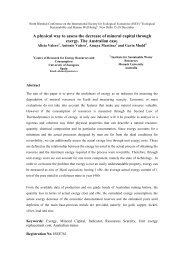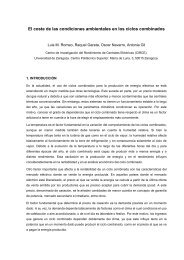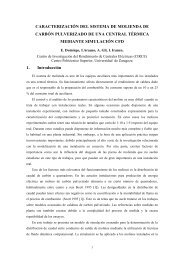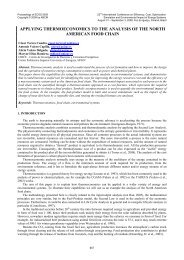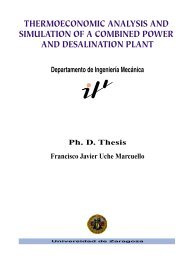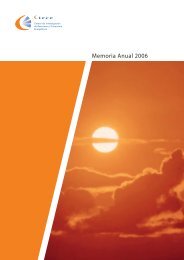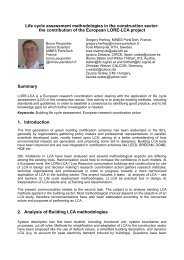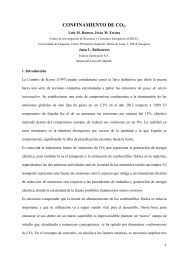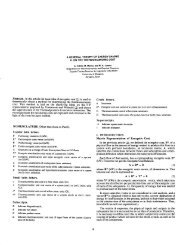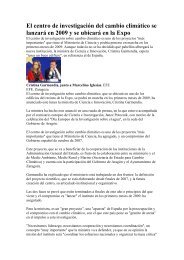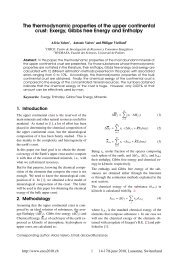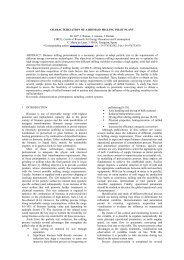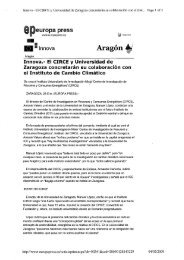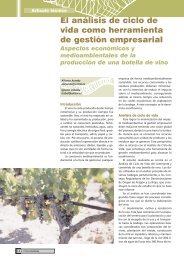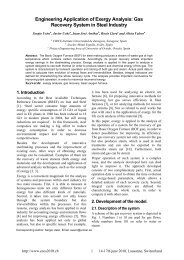towards an international legal reference environment
towards an international legal reference environment
towards an international legal reference environment
Create successful ePaper yourself
Turn your PDF publications into a flip-book with our unique Google optimized e-Paper software.
TOWARDS AN INTERNATIONAL LEGAL REFERENCE<br />
ENVIRONMENT<br />
J<strong>an</strong> Szargut*, Antonio Valero**, Wojciech St<strong>an</strong>ek* <strong>an</strong>d Alicia Valero**<br />
*Silesi<strong>an</strong> University of Technology; Institute of Thermal Technology<br />
Gliwice, Pol<strong>an</strong>d<br />
**Centro de Investigación de Recursos y Consumos Energeticos<br />
Zaragoza, Spain<br />
ABSTRACT<br />
The determination of the natural capital exergy is linked to the definition <strong>an</strong>d thermodynamic<br />
properties of the Reference Environment (R.E.) used. Hence the import<strong>an</strong>ce of <strong>an</strong> appropriate<br />
selection of the R.E. The aim of this paper is to obtain <strong>an</strong>d propose in ECOS 2005, <strong>an</strong> agreement<br />
on the <strong>legal</strong> <strong>international</strong> <strong>reference</strong> <strong>environment</strong> for evaluating the natural resources on Earth. For<br />
this purpose, all the R.E. models published so far are systematically <strong>an</strong>alyzed, the best suitable<br />
methodology for calculating the st<strong>an</strong>dard chemical exergy of the chemical elements is chosen <strong>an</strong>d<br />
shown <strong>an</strong>d the variables used in the chosen methodology are updated using new geochemistry<br />
information <strong>an</strong>d revisions done by other authors.<br />
Keywords: Reference Environment, Reference Subst<strong>an</strong>ce, St<strong>an</strong>dard Chemical Exergy, Natural capital<br />
INTRODUCTION<br />
The natural capital c<strong>an</strong> be evaluated from different<br />
points of view. One of them, <strong>an</strong>d perhaps the most<br />
commonly known is the economic point of view.<br />
Nevertheless, as Naredo [1] <strong>an</strong>alyzes, st<strong>an</strong>dard economy<br />
is only concerned with what which being directly<br />
useful to m<strong>an</strong>, is also acquirable, valuable <strong>an</strong>d<br />
produce-able. For this reason, most of the natural<br />
resources, remain outside the object of <strong>an</strong>alysis<br />
of the economic system. The price-fixing mech<strong>an</strong>isms,<br />
rarely take into account the concrete physical<br />
characteristics which make them valuable. But natural<br />
capital has at least two physical features which<br />
make minerals or fresh water for example unusual:<br />
a particular composition which differentiates them<br />
from the surrounding <strong>environment</strong>, <strong>an</strong>d a distribution<br />
which places them in a specific concentration.<br />
These intrinsic properties, c<strong>an</strong> be in fact evaluated<br />
from a thermodynamic point of view in terms of<br />
exergy [2].<br />
The thermodynamic value of a natural resource<br />
could be defined as the minimum work necessary<br />
to produce it with a specific structure <strong>an</strong>d concentration<br />
from common materials in the <strong>environment</strong>.<br />
This minimum amount of work is theoretical by definition<br />
<strong>an</strong>d is equal to the material’s exergy (Riekert<br />
[3]). The exergy of a system gives <strong>an</strong> idea of<br />
its evolution potential for not being in thermodynamic<br />
equilibrium with the <strong>environment</strong>, or what is<br />
the same, for not being in a dead state related to the<br />
Reference Environment (R.E.). Therefore, for calculating<br />
the exergy of <strong>an</strong>y natural resource, a R.E.<br />
should be defined. This R.E. must be determined by<br />
the natural <strong>environment</strong> <strong>an</strong>d c<strong>an</strong> be assimilated to a<br />
thermodynamically dead pl<strong>an</strong>et where all materials<br />
have reacted, dispersed <strong>an</strong>d mixed.<br />
Each of the R.E. definitions are fixed by their chemical<br />
composition. They have therefore different values<br />
of <strong>reference</strong> exergy <strong>an</strong>d generate different exergies.<br />
This implies that the determination of the natural<br />
capital exergy is necessarily linked to the definition<br />
<strong>an</strong>d thermodynamic properties of the R.E.
Hence the import<strong>an</strong>ce of <strong>an</strong> appropriate selection of<br />
a R.E. for evaluating natural resources.<br />
SEARCHING THE BEST SUITABLE R.E.<br />
CATEGORY<br />
So far, there have been m<strong>an</strong>y contributions to the determination<br />
of a R.E. They could be divided into two<br />
main groups: Partial <strong>an</strong>d Comprehensive Reference<br />
Environments.<br />
It is well known, that some authors such as Bosnjakovich<br />
[4], Gaggioli <strong>an</strong>d Petit [5] <strong>an</strong>d Sussm<strong>an</strong><br />
[6] established that the R.E. should be defined according<br />
to the specific characteristics of the <strong>an</strong>alyzed<br />
process. This criterion is based on that being<br />
the exergy a parameter that qu<strong>an</strong>tifies the theoretical<br />
evolution of a system with respect to the R.E., some<br />
of the possible evolutions of the system, c<strong>an</strong>not be<br />
attained because of process limitations. Hence, only<br />
possibilities of evolution that the system c<strong>an</strong> practically<br />
attain are <strong>an</strong>alyzed. The R.E. is not a “dead<br />
state” <strong>an</strong>ymore. For computing exergy ch<strong>an</strong>ges of<br />
variable composition or chemically reactive steady<br />
flow processes, a Comprehensive Reference Environment<br />
is generally unnecessary. However, this is<br />
not the case when the point is to evaluate the natural<br />
capital on Earth. In this case, there are no process<br />
limitations <strong>an</strong>d the resources c<strong>an</strong> follow <strong>an</strong> evolution<br />
process <strong>towards</strong> the dead state, thus a comprehensive<br />
R.E. is required.<br />
Within the known Comprehensive Reference Environments,<br />
all authors agree in dividing the Reference<br />
Subst<strong>an</strong>ces (R.S.) that compose the R.E. into<br />
gaseous components of the atmospheric air, solid<br />
components of the external layer of the Earth’s crust,<br />
<strong>an</strong>d molecular components of seawater. Nevertheless,<br />
there are also criterion differences between the<br />
different authors. They could be classified into <strong>environment</strong>s<br />
based on 1) Szargut’s criterion, 2) Chemical<br />
equilibrium <strong>an</strong>d 3) Abund<strong>an</strong>ce.<br />
Abund<strong>an</strong>ce <strong>an</strong>d Szargut’s criterion are not opposite<br />
criteria. According to Szargut’s criterion, among a<br />
group of reasonable abund<strong>an</strong>t subst<strong>an</strong>ces, the most<br />
stable will be chosen if they also complain with the<br />
“Earth similarity criterion”. That is, if the stability<br />
of the possible different <strong>reference</strong> subst<strong>an</strong>ces for a<br />
specific element (measured in terms of the formation<br />
Gibbs energy) is within a certain threshold, then<br />
the most abund<strong>an</strong>t R.S. will be chosen. If the differences<br />
exceed this threshold, the most stable sub-<br />
st<strong>an</strong>ce will be taken as R.S. as long as it does not<br />
contradict the “Earth similarity criterion”. The stability<br />
threshold has not a fix value <strong>an</strong>d depends on<br />
each element considered, since it is subjected to geological<br />
uncertainties. Thus for example in the case<br />
of Sb, the subst<strong>an</strong>ce Sb2S3 is more abund<strong>an</strong>t th<strong>an</strong><br />
Sb2O5, nevertheless, according to Szargut’s criterion,<br />
Sb2O5, which is much more stable, will be<br />
taken as <strong>reference</strong> subst<strong>an</strong>ce. This happens also with<br />
the subst<strong>an</strong>ces listed in table 1. Nevertheless nitrates<br />
such as Ca(NO3)2, NaNO3, KNO3 are discarded,<br />
because being most stable but not abund<strong>an</strong>t<br />
in the natural <strong>environment</strong>, would break the similarity<br />
criterion if they are taken as R.S. Therefore,<br />
Szargut’s [7] dead <strong>environment</strong> is similar to the real<br />
physical <strong>environment</strong> <strong>an</strong>d should represent the products<br />
of <strong>an</strong> interaction between the components of<br />
the natural <strong>environment</strong> <strong>an</strong>d the waste products of<br />
the processes. The most probable products of this<br />
interaction should be chosen as <strong>reference</strong> species.<br />
Next section explains purposively the well known<br />
Szargut’s methodology for obtaining the chemical<br />
exergy of the elements from the R.E.<br />
Some authors define the chemical exergy by me<strong>an</strong>s<br />
of the chemical equilibrium with the real <strong>environment</strong>.<br />
Szargut stresses that it is not possible to attain<br />
<strong>an</strong> equilibrium with the system being not in the state<br />
of internal equilibrium (<strong>an</strong>d the natural <strong>environment</strong><br />
is far away from such equilibrium). Ahrendts [8]<br />
<strong>an</strong>d Diederichsen [9] for example, stated that if<br />
the amount of different elements in the <strong>reference</strong><br />
system is known <strong>an</strong>d the temperature of the system<br />
is fixed, the qu<strong>an</strong>tity of each chemical compound<br />
<strong>an</strong>d the value of each chemical potential is<br />
uniquely determined by the condition of chemical<br />
equilibrium. Even though Ahrendt’s R. E. only included<br />
15 elements, they represented more th<strong>an</strong> 99%<br />
of the Earth’s crust <strong>an</strong>d thus his R.E. c<strong>an</strong> be considered<br />
as a Comprehensive Reference Environment.<br />
Ahrendts calculated the composition of this <strong>environment</strong><br />
in chemical equilibrium, having as a variable<br />
parameter the thickness of the crust layer.<br />
Valero, R<strong>an</strong>z <strong>an</strong>d Botero [2], explained already why<br />
Ahrendt’s R.E. was not suitable to evaluate the natural<br />
capital on Earth. Most of the metals c<strong>an</strong>not<br />
be evaluated because they form part of the 1% of<br />
the Earth’s crust neglected by Ahrendts. His obtained<br />
R.E. is very different from the real <strong>environment</strong><br />
<strong>an</strong>d it is very unlikely <strong>an</strong> eventual evolution
<strong>towards</strong> it, since some processes are kinetically, biologically<br />
<strong>an</strong>d/or geologically blocked.<br />
Diederichsen updated <strong>an</strong>d extended Ahrendt’s<br />
model with new geochemical data <strong>an</strong>d obtained<br />
among others, a R. E. including 75 elements. Furthermore,<br />
he allowed the composition of this <strong>environment</strong><br />
to ch<strong>an</strong>ge with two variable parameters:<br />
thickness of the Earth’s crust <strong>an</strong>d oce<strong>an</strong>’s depth. The<br />
final chosen <strong>environment</strong> should comply with the<br />
“Earth similarity criterion”. The similarity with the<br />
Earth was measured with the equilibrium pressure,<br />
the oxygen <strong>an</strong>d nitrogen content in the gas-phase<br />
<strong>an</strong>d the equilibrium salt content in the oce<strong>an</strong>s.<br />
Even though Diederichsen [9] added more elements<br />
th<strong>an</strong> Ahrendts [8] <strong>an</strong>d included a new variable parameter,<br />
the composition of his new Reference Environment<br />
is still too different from the real Earth. According<br />
to the “Earth similarity criterion”, the R.E.<br />
that best fits with the Earth’s <strong>environment</strong> takes a<br />
crust thickness of only 0,1 m <strong>an</strong>d <strong>an</strong> oce<strong>an</strong>’s depth<br />
of 100 m. Greater values would move further away<br />
the R.E. from the real Earth, <strong>an</strong>d would have among<br />
other features, reduced pressures <strong>an</strong>d oxygen contents.<br />
As it happened with Ahrendt’s model before,<br />
Diederichsen obtained high exergy values for oxygen.<br />
This happens because nearly all the oxygen of<br />
the air is consumed basically by the formation of nitrates<br />
<strong>an</strong>d only in the limit, for a crust thickness of<br />
0 m, the me<strong>an</strong> Earth pressure matches with that of<br />
the model. It seems therefore that achieving a R.E.<br />
in chemical equilibrium is in disagreement with the<br />
“Earth similarity criterion” <strong>an</strong>d is not appropriate<br />
for the evaluation of natural capital on Earth. This<br />
idea fully fits with Lovelock’s Gaia hypothesis [10]:<br />
the Earth is a life being <strong>an</strong>d fights against thermodynamic<br />
stable equilibrium.<br />
Kameyama et al. [11] proposed a <strong>reference</strong> <strong>environment</strong><br />
with the criterion of chemical stability. The<br />
<strong>reference</strong>s are the most stable compounds among<br />
those with thermo-chemical data <strong>an</strong>d c<strong>an</strong> be integrated<br />
in the solid, liquid <strong>an</strong>d gaseous <strong>environment</strong>s.<br />
As Szargut stated in [12], some of the<br />
most stable compounds selected by Kameyama et<br />
al. like nitrates, compounds between rare elements<br />
(e.g. PtBr2) or compounds with Fr as the <strong>reference</strong><br />
species for the elements F, Cl, Br, I should not be<br />
recommended, because the probability of their formation<br />
in the <strong>environment</strong> is very small. Therefore,<br />
Kameyama et al. R.E. is not very suitable either to<br />
evaluate the scarcity of the natural capital.<br />
According to R<strong>an</strong>z [13], lots of minerals are compounds<br />
with the most common components of the<br />
upper continental crust, but are not very stable<br />
<strong>an</strong>d do not represent the products of <strong>an</strong> interaction<br />
between the components of the natural <strong>environment</strong><br />
<strong>an</strong>d the waste products of industrial processes.<br />
Hence, R<strong>an</strong>z [13] proposes a new R.E. very close to<br />
the real <strong>environment</strong> based on abund<strong>an</strong>ce <strong>an</strong>d following<br />
Szargut’s criterion. The solid phase of this<br />
new R.E. reproduces accurately the Earth’s upper<br />
continental crust, since the solid <strong>reference</strong> species<br />
that make up this <strong>environment</strong> are the same as the<br />
most abund<strong>an</strong>t types found in the Earth’s upper continental<br />
crust. A problem with the R<strong>an</strong>z proposed<br />
R.E. is that if we assign zero exergy to the most<br />
abund<strong>an</strong>t subst<strong>an</strong>ces, we are decreasing arbitrarily<br />
the natural capital, because m<strong>an</strong>y abund<strong>an</strong>t minerals<br />
like sulfides naturally evolute to the most stable<br />
oxides. Therefore, as proposed by Valero, R<strong>an</strong>z<br />
<strong>an</strong>d Botero [2], we must return to Szargut’s criterion<br />
of using the most stable subst<strong>an</strong>ce, within the limits<br />
fixed by the “Earth similarity criterion”.<br />
Hence, our goal is to obtain <strong>an</strong> agreed <strong>legal</strong> <strong>international</strong><br />
<strong>reference</strong> state for evaluating the natural resources<br />
on Earth, based on Szargut’s criterion <strong>an</strong>d<br />
methodology <strong>an</strong>d using the more precise data used<br />
by R<strong>an</strong>z <strong>an</strong>d other authors such as Rivero [14], as<br />
well as new geochemical updates.<br />
In the next section, Szargut’s R.E. methodology is<br />
explained <strong>an</strong>d the variables used are discussed.<br />
CALCULATION METHODOLOGY: STAN-<br />
DARD CHEMICAL EXERGY OF THE<br />
CHEMICAL ELEMENTS<br />
Chemical exergy expresses the exergy of a subst<strong>an</strong>ce<br />
at ambient temperature <strong>an</strong>d pressure. It is defined as<br />
a maximum work which c<strong>an</strong> be obtained when the<br />
considered subst<strong>an</strong>ce is brought in a reversible way<br />
to the state of <strong>reference</strong> subst<strong>an</strong>ces present in the <strong>environment</strong>,<br />
using the <strong>environment</strong> as a source of heat<br />
<strong>an</strong>d of <strong>reference</strong> subst<strong>an</strong>ces necessary for the realization<br />
of the described process. The R.S. most common<br />
in the <strong>environment</strong> are accepted separately for<br />
every chemical element, <strong>an</strong>d are mutually independent.<br />
Hence, the problem of equilibrium between<br />
the <strong>reference</strong> subst<strong>an</strong>ces does not exist. It is impossible<br />
to formulate a chemical reaction in which only<br />
the <strong>reference</strong> subst<strong>an</strong>ces take part.
St<strong>an</strong>dard chemical exergy of chemical compounds<br />
Methodology<br />
St<strong>an</strong>dard chemical exergy results from a conventional<br />
assumption of a st<strong>an</strong>dard ambient temperature<br />
<strong>an</strong>d pressure <strong>an</strong>d st<strong>an</strong>dard concentration of <strong>reference</strong><br />
subst<strong>an</strong>ces in the natural <strong>environment</strong>.<br />
The st<strong>an</strong>dard chemical exergy of <strong>an</strong>y chemical<br />
compound c<strong>an</strong> be calculated by me<strong>an</strong>s of the exergy<br />
bal<strong>an</strong>ce of a reversible formation reaction;<br />
bchn = ∆G f +∑ e<br />
ne bchne<br />
(1)<br />
where:<br />
∆G f formation Gibbs energy<br />
ne amount of kmol of the element e<br />
bchne st<strong>an</strong>dard chemical exergy of the element.<br />
If the chemical element does not belong to the <strong>reference</strong><br />
subst<strong>an</strong>ces, its st<strong>an</strong>dard chemical exergy c<strong>an</strong><br />
also be calculated from Eq. 1, however, a <strong>reference</strong><br />
reaction of this element should be formulated. This<br />
reaction contains only <strong>reference</strong> subst<strong>an</strong>ces, additional<br />
as react<strong>an</strong>ts <strong>an</strong>d final as products. For example,<br />
following <strong>reference</strong> reaction holds for the element<br />
C: C+O2 = CO2, where O2 is the additional<br />
<strong>an</strong>d CO2 the final <strong>reference</strong> subst<strong>an</strong>ce. The st<strong>an</strong>dard<br />
chemical exergy of the <strong>reference</strong> subst<strong>an</strong>ces are calculated<br />
prior to the st<strong>an</strong>dard chemical exergy of the<br />
element.<br />
Discussion of the variables used<br />
The formation Gibbs energy used by Szargut [12]<br />
was revised by Rivero [14] using [15], [16], [17],<br />
[18] <strong>an</strong>d [19]. No subst<strong>an</strong>tial differences were<br />
found, except for sillim<strong>an</strong>ite (Al2SiO5), whose new<br />
value is ∆G f = 2440,9 kJ/mol. The information<br />
source of R<strong>an</strong>z [13] for obtaining ∆G f , was Faure<br />
[20], which is a compilation of the literature from<br />
several authors. This source corroborates Rivero’s<br />
revision <strong>an</strong>d thus, it will be considered for the calculation<br />
of our particular R.E.<br />
Gaseous <strong>reference</strong> subst<strong>an</strong>ces<br />
Methodology<br />
Free chemical elements present in the atmospheric<br />
air (O2, N2, Ar, He, Ne, Kr, Xe) <strong>an</strong>d the compounds<br />
H2O, CO2 are assumed as <strong>reference</strong> sub-<br />
st<strong>an</strong>ces. Their st<strong>an</strong>dard chemical exergy results from<br />
the conventional st<strong>an</strong>dard concentration in the atmosphere;<br />
bchn = −RT0 ln P0n<br />
= −RT0 ln z0<br />
Pn<br />
(2)<br />
where:<br />
R gas const<strong>an</strong>t,<br />
T0 st<strong>an</strong>dard ambient temperature (298,15 K),<br />
P0n conventional me<strong>an</strong> ideal gas partial pressure<br />
in the atmosphere (kPa),<br />
Pn st<strong>an</strong>dard pressure (101,325 kPa),<br />
z0 conventional st<strong>an</strong>dard molar fraction in the<br />
<strong>environment</strong>.<br />
The values of st<strong>an</strong>dard chemical exergy of gaseous<br />
<strong>reference</strong> subst<strong>an</strong>ces O2, H2O, CO2, N2 are calculated<br />
before other values because they are necessary<br />
in the calculation of st<strong>an</strong>dard chemical exergy of<br />
non-gaseous <strong>reference</strong> subst<strong>an</strong>ces.<br />
Discussion of the variables used<br />
The universal gas const<strong>an</strong>t is used (8,3143 kJ/(kmol<br />
K)) <strong>an</strong>d the calculated st<strong>an</strong>dard chemical exergy relates<br />
to 1 kmol. Rivero <strong>an</strong>d Garfias [14] accepted<br />
the <strong>reference</strong> pressure according to the conventional<br />
unit “physical atmosphere”, thus 101,325 kPa. We<br />
are assuming the me<strong>an</strong> partial pressure calculated by<br />
Szargut <strong>an</strong>d used by R<strong>an</strong>z [13], which is the really<br />
appearing me<strong>an</strong> value <strong>an</strong>d is equal to 99,31 kPa.<br />
Table 2 shows the results obtained in this study for<br />
the chemical exergy of the gaseous subst<strong>an</strong>ces. The<br />
obtained values are the same of those obtained by<br />
Szargut [12] <strong>an</strong>d Valero, R<strong>an</strong>z <strong>an</strong>d Botero [2], since<br />
the methodology <strong>an</strong>d the values used for this R.E.<br />
has been the same. The differences with Rivero <strong>an</strong>d<br />
Garfias [14] are due to the different partial pressures<br />
in the atmosphere taken.<br />
Solid <strong>reference</strong> subst<strong>an</strong>ces<br />
Methodology<br />
For a prevailing part of chemical elements, solid<br />
R.S. commonly appearing in the external layer of<br />
the continental part of Earth’s crust, have been assumed.<br />
However, the Earth’s crust is a very complicated<br />
mixture of solid solutions <strong>an</strong>d <strong>an</strong> exact calculation<br />
of the chemical exergy of its components<br />
is impossible. We c<strong>an</strong> only approximately evaluate
that exergy, assuming that the <strong>reference</strong> species behave<br />
as components of <strong>an</strong> ideal solution. Hence, Eq.<br />
2 c<strong>an</strong> be applied also in this case.<br />
The evaluation of the st<strong>an</strong>dard molar concentration<br />
of solid R.S. in the external layer of the Earth’s crust<br />
is difficult. In past geochemical publications we c<strong>an</strong><br />
only find a me<strong>an</strong> mass concentration of particular<br />
chemical elements <strong>an</strong>d some information about the<br />
chemical compounds containing the considered elements.<br />
Hence, the best considered way so far to obtain<br />
the st<strong>an</strong>dard molar concentration of R.S. in the<br />
solid <strong>environment</strong>, has been with following equation<br />
suggested by Szargut in [12]:<br />
z0i = 1<br />
n0i ci M0<br />
li<br />
where:<br />
n0i me<strong>an</strong> molar concentration (in mol/kg) of<br />
the i-th element in the continental part of the<br />
Earth’s crust,<br />
number of the atoms of i-th element in the<br />
li<br />
molecule of the <strong>reference</strong> species,<br />
(3)<br />
ci fraction of the i-th element appearing in the<br />
form of <strong>reference</strong> species,<br />
M0 me<strong>an</strong> molecular mass of the upper layer of<br />
the continental part of Earth’s crust.<br />
The <strong>reference</strong> reactions of the elements having solid<br />
R.S. contain usually the gaseous R.S. Sometimes<br />
appear also solid <strong>reference</strong> species. For example,<br />
the solid R.S. of Mg is Mg3Si4O10(OH)2 the<br />
<strong>reference</strong> reaction for the element Mg has a form:<br />
3 Mg+4 SiO2 + 1,5 O2 + H2O = Mg3Si4O10(OH)2<br />
In such case the st<strong>an</strong>dard chemical exergy of the<br />
appearing solid <strong>reference</strong> subst<strong>an</strong>ce should be<br />
calculated prior to the calculation of the chemical<br />
exergy of the considered element.<br />
Discussion of the variables used<br />
The me<strong>an</strong> molar concentration of the elements in<br />
the upper continental crust n0i, used in Szargut [12],<br />
was the recommended by Pol<strong>an</strong>ski <strong>an</strong>d Smulikowski<br />
[21]. R<strong>an</strong>z [13] used updated values mainly from<br />
Taylor <strong>an</strong>d McLenn<strong>an</strong> [22], [23]. For the elements:<br />
Br, C, Cl, F, S, Pt, Pu, Ra, Rh, Ru, Te, I, Hg <strong>an</strong>d N,<br />
Taylor <strong>an</strong>d Mclenn<strong>an</strong> did not provide <strong>an</strong>y information,<br />
therefore, R<strong>an</strong>z used the values given by Wedepohl<br />
[24] for S, Br, C, F, I, Hg, N <strong>an</strong>d for the remainig<br />
elements, the values used by Szargut [12].<br />
Some authors like Pl<strong>an</strong>k <strong>an</strong>d L<strong>an</strong>gmuir [25] basing<br />
on their studies on marine sediments, suggested already<br />
in 1998 some revisions of the estimated values<br />
by Taylor <strong>an</strong>d McLenn<strong>an</strong> [22], [23] for Nb, Cs,Ti,<br />
Ta. As a consequence, McLenn<strong>an</strong> [26] published<br />
in year 2001 new me<strong>an</strong> molar concentrations of the<br />
upper continental crust for the elements: Sc, Ti, V ,<br />
Co, Ni, Nb, Cs, Pb, Ta. Grigor’ev published in year<br />
2000 [27] the average mineral content of the upper<br />
continental crust obtained through a great number<br />
of qu<strong>an</strong>titative mineralogical <strong>an</strong>alysis of import<strong>an</strong>t<br />
rocks published mainly in the USSR <strong>an</strong>d USA. Recently,<br />
Grigor’ev updated this information; this new<br />
<strong>an</strong>alysis comprises 255 minerals corresponding to<br />
99,13% of the total mineral content of the upper continental<br />
crust. Although Grigor’ev has not published<br />
this information yet, he gave permission to the authors<br />
of this paper, to use it. This valuable information<br />
will allow to obtain directly the st<strong>an</strong>dard molar<br />
concentration of the following 12 <strong>reference</strong> subst<strong>an</strong>ces<br />
in the solid <strong>environment</strong> without using Eq.<br />
3: BaSO4, CaCO3, Au, Fe2O3, Mg3Si4O10(OH)2,<br />
MnO2, SiO2, SrCO3, T hO2, SnO2, TiO2, ZrSiO4.<br />
For the rest subst<strong>an</strong>ces, Eq. 3 must be used, taking<br />
n0i from the latest geochemical publications. First<br />
the values from McLenn<strong>an</strong> [26] completed with<br />
those from Wedepohl [24] will be used. For the remaining<br />
elements not appearing in the latter publications,<br />
n0i used by Szargut [12] will be applied.<br />
The me<strong>an</strong> molecular mass of the upper layer of the<br />
continental part of the Earth’s crust, was first estimated<br />
by Szargut [28]. The obtained value was<br />
M0= 135,5 kg/kmol, applying the following estimation<br />
method: according to the geochemical data, the<br />
me<strong>an</strong> concentration values (in mol/kg) of particular<br />
chemical groups or elements in the external layer of<br />
the continental Earth’s crust <strong>an</strong>d the chemical compound<br />
formed from these groups were assumed. The<br />
first considered group was CO2, which appears in<br />
the Earth’s crust mainly in carbonates of Ca, Mg <strong>an</strong>d<br />
Fe. Per 1 mol of (CaO + MgO + FeO) 0,035 mol of<br />
CO2 are present. The group CO2 was partitioned between<br />
the mentioned groups <strong>an</strong>d elements Zn, Cu,<br />
Pb <strong>an</strong>d Cd, appearing also in the form of carbonates.<br />
The group SO3 was partitioned between CaO<br />
<strong>an</strong>d MgO forming sulphates. It was assumed that a<br />
prevailing part of metals (Sn, Co, Mn, Fe, Ni) appears<br />
in form of different oxides (Co2O3, Co3O4,<br />
Fe2O3, Fe3O4). It was also assumed that 8% of
Fe appears in form of free oxide Fe2O3. The remaining<br />
part appears in form of FeTiO3, FeCr2O3<br />
<strong>an</strong>d silicates. For example, following silicates<br />
were assumed: NaAlSi3O8, KAlSi3O8, NaFeSi2O6,<br />
MgSiO3, CaO.Al2Si2O7. Because of the large content<br />
of SiO2, a considerable part of it was assumed<br />
in free form. After estimating the composition of a<br />
me<strong>an</strong> sample of the lithosphere, its molecular mass<br />
was calculated.<br />
R<strong>an</strong>z [13] updated the molecular mass of the upper<br />
continental crust using more recent geochemical<br />
information <strong>an</strong>d adopting not only a geochemical<br />
approach, but also a geological one. The methodology<br />
used was as follows: The <strong>international</strong><br />
accepted norm CIPW [29] was applied to the mass<br />
fractions of the principal oxide groups obtained by<br />
Carmichael [30] for the cratonic <strong>an</strong>d sedimentary<br />
layers, in order to redistribute the chemical components<br />
from the oxides to the mineral molecules<br />
that are representative in real minerals appearing in<br />
a rock. Next, the minerals of the norm <strong>an</strong>d their<br />
respective relative masses were modified to adjust<br />
them to the real volumes of the principal groups of<br />
each rock. Finally, their molar fractions were calculated<br />
<strong>an</strong>d the me<strong>an</strong> molecular mass of the whole<br />
was obtained. The resulting M0 was equal to 145,5<br />
kg/kmol. Even though this methodology used better<br />
geochemical values th<strong>an</strong> the ones in Szargut [28],<br />
<strong>an</strong>d included the geological approach, we c<strong>an</strong>not<br />
forget that the CIPW norm is <strong>an</strong> artificial way to obtain<br />
the possible minerals that c<strong>an</strong> appear in a rock.<br />
It is therefore only <strong>an</strong> approximation as well.<br />
In the light of Grigor’ev’s <strong>an</strong>alysis, a more accurate<br />
molecular weight of the upper continental crust,<br />
based on experimental results rather th<strong>an</strong> assumptions,<br />
c<strong>an</strong> be easily obtained. The new calculated<br />
value is M0= 143,4 kg/kmol, which is very close to<br />
the estimation done by R<strong>an</strong>z. The difference in the<br />
chemical exergy of the elements obtained with the<br />
new molecular weight is almost negligible: in average,<br />
taking a molecular weight equal to 143,4 instead<br />
of 145,5, makes a difference in the exergy of<br />
the solid <strong>reference</strong> subst<strong>an</strong>ces of only 0,007%.<br />
For the fraction of the i-th element appearing in the<br />
form of <strong>reference</strong> species (coefficient ci), Szargut<br />
[31] associates values comprised between 0,5 for<br />
more abund<strong>an</strong>t subst<strong>an</strong>ces <strong>an</strong>d 0,001 for less frequent<br />
subst<strong>an</strong>ces from geochemical data given by<br />
Pol<strong>an</strong>ski <strong>an</strong>d Smulikowski [21]. R<strong>an</strong>z [13] obtained<br />
more accurate ci coefficients for solid R.S. containing<br />
the most abund<strong>an</strong>t elements in the upper continental<br />
crust. For this purpose, she used the mineralogical<br />
composition of the Earth’s upper layer<br />
obtained with the CIPW norm before <strong>an</strong>d updated<br />
geochemical information, mainly from Taylor <strong>an</strong>d<br />
McLenn<strong>an</strong> [23]. For minority elements, due to the<br />
lack of information, Szargut’s [31] values were used.<br />
As long as a better mineralogical composition of the<br />
Earth’s crust is done <strong>an</strong>d the ci coefficients are recalculated<br />
with this information, we will assume the ci<br />
values obtained by R<strong>an</strong>z [13]. Nevertheless, it must<br />
be stressed that choosing a certain ci or <strong>an</strong>other a<br />
100 times greater, throws less differences in the chemical<br />
exergy of the elements th<strong>an</strong> choosing <strong>an</strong>other<br />
R.S.<br />
Table 4 shows the results obtained in this study for<br />
the chemical exergy of the solid subst<strong>an</strong>ces. The<br />
solid R.S. assumed were those taken by Szargut<br />
[12], basing on the Szargut’s criterion mentioned<br />
before. The new chemical exergies obtained differ in<br />
1,1% in average with respect to the values obtained<br />
by Szargut in [12]. Taking the empirical st<strong>an</strong>dard<br />
molar concentration of solid R.S. found in Grigor’ev<br />
[27] instead of calculating it with Eq. 3, implies<br />
a difference in the element chemical exergy of less<br />
th<strong>an</strong> 4% except for Au (14%) <strong>an</strong>d F (18%). For the<br />
latter elements, the greater difference is due to the<br />
greater sensitivity of Au to z0, since its ∆G is equal<br />
to zero <strong>an</strong>d the great proportion of atoms of Ca in<br />
the <strong>reference</strong> subst<strong>an</strong>ce of F, respectively.<br />
Reference subst<strong>an</strong>ces dissolved in seawater<br />
Methodology<br />
Assumption of ionic or molecular R.S. dissolved in<br />
seawater ensures in m<strong>an</strong>y cases more exact determination<br />
of st<strong>an</strong>dard chemical exergy of chemical elements<br />
when compared with solid R.S. The calculation<br />
methods of thermodynamic functions of monocharged<br />
<strong>an</strong>d bicharged ions are relatively exact. This<br />
is the case also when the <strong>reference</strong> subst<strong>an</strong>ce is dissolved<br />
in molecular form with a very small degree<br />
of ionization.<br />
The method of calculation of st<strong>an</strong>dard chemical<br />
exergy of elements with R.S. dissolved in seawater<br />
has been developed by Morris [32]:
chn = j −∆Gf + 0.5zbchH2 −∑ νk bchk −<br />
k<br />
<br />
− RTn [2.303z(pH) + ln mn γ]<br />
where:<br />
j number of <strong>reference</strong> ions or molecules<br />
derived from one molecule of<br />
the element under consideration,<br />
∆G f formation Gibbs energy of the R.S.,<br />
z number of elementary positive<br />
charges of the <strong>reference</strong> ion,<br />
νk number of molecules of additional<br />
elements present in the molecule of<br />
<strong>reference</strong> subst<strong>an</strong>ce,<br />
bchH2 ,bchk st<strong>an</strong>dard chemical exergy of hydrogen<br />
gas <strong>an</strong>d of the k-th additional<br />
element.<br />
(4)<br />
mn conventional st<strong>an</strong>dard molarity of<br />
the <strong>reference</strong> subst<strong>an</strong>ce in seawater,<br />
γ activity coefficient (molarity scale)<br />
of the <strong>reference</strong> subst<strong>an</strong>ce in seawater,<br />
pH exponent of the concentration of hydrogen<br />
ion in seawater (=8,1)<br />
The activity coefficient of single ion c<strong>an</strong> be calculated<br />
by me<strong>an</strong>s of the Debye-Huckel equation:<br />
− logγi = Az2 √<br />
i I<br />
1 + ai B √ (5)<br />
I<br />
where:<br />
A = 0,51 kg 1/2 mol −1/2 for water at 25 o C,<br />
B = 3,287 * 10 9 kg 1/2 m −1 mol −1/2 for water<br />
at 25 o C,<br />
ai effective diameter of the ion,<br />
I ionic strength of the electrolyte.<br />
The ionic strength of the electrolyte results from the<br />
following equation:<br />
I = 1<br />
2 ∑ i<br />
mi zi 2<br />
(6)<br />
where:<br />
mi molarity of the ion, mol/kg H2O,<br />
zi number of elementary electric charges of<br />
the ion.<br />
The ion Cl − prevails among the negative ions in seawater.<br />
Therefore, the data of chlorides c<strong>an</strong> be assumed<br />
for activity coefficients of the positive ions<br />
Na + , K + . The activity coefficients of the negative<br />
ions Cl− <strong>an</strong>d SO −2<br />
4 c<strong>an</strong> be estimated in <strong>reference</strong> to<br />
the predomin<strong>an</strong>t positive ion Na + .<br />
Discussion of the variables used<br />
The positive ionic R.S. have been assumed for the<br />
elements from the first column of the periodic system<br />
<strong>an</strong>d for the monocharged <strong>an</strong>d bicharged negative<br />
ions formed from acids. The elements from the<br />
second column of the periodic system appear in the<br />
seawater in form of positive bicharged ions, however,<br />
they are not recommended as R.S., because the<br />
so calculated st<strong>an</strong>dard chemical exergy of the elements<br />
leads to negative values of chemical exergy<br />
of some solid compounds common in the Earth’s<br />
crust. Rivero <strong>an</strong>d Garfias [14] have found the influence<br />
of salinity of seawater on the calculated values<br />
of st<strong>an</strong>dard chemical exergy of elements calculated<br />
by me<strong>an</strong>s of <strong>reference</strong> subst<strong>an</strong>ces dissolved in seawater.<br />
However, <strong>an</strong> increased salinity (greater th<strong>an</strong><br />
35 appears seldom (Red Sea), <strong>an</strong>d the deviations<br />
are not large (usually less th<strong>an</strong> 1,6%). Every introduction<br />
of solid <strong>reference</strong> subst<strong>an</strong>ces c<strong>an</strong> decrease<br />
the accuracy of calculations. Therefore we are assuming<br />
the solid <strong>reference</strong> subst<strong>an</strong>ces only for the<br />
elements from the second column of the periodic<br />
system. Following ionic <strong>an</strong>d molecular <strong>reference</strong><br />
subst<strong>an</strong>ces dissolved in seawater have been accepted<br />
in the recent publication of Szargut [33] <strong>an</strong>d will be<br />
used for this proposal:<br />
Cl− , AgCl − 2 , B(OH)3 aq, BiO + , Br− , CdCl2 aq,<br />
Cs + , Cu +2 , HPO −2<br />
4 , HAsO−2 4 , HgCl−2 4 , IO− 3 , K+ ,<br />
Li + , MoO −2<br />
4 , Na+ , Ni +2 , PbCl2 aq, Rb + , SO −2<br />
4 ,<br />
SeO −2<br />
4 , WO−2<br />
4 , Zn+2 .<br />
Major ions in seawater are ions with fractions<br />
greater th<strong>an</strong> 1 ppm. The Seawater Reference Environment<br />
taken into account in this proposal com-<br />
prises the following major ions: Na + , K + , HAsO −2<br />
4 ,<br />
BiO + , Cl − , SO −2<br />
4 , Br− , B(OH)3. Values of the activity<br />
coefficients <strong>an</strong>d molarity of these species basing<br />
on information presented in Millero [34], Pilson<br />
[35] <strong>an</strong>d Mottl [36] were reviewed <strong>an</strong>d compared<br />
with those which R<strong>an</strong>z <strong>an</strong>d Rivero took into<br />
account. With the exception of SO −2<br />
4 the differences<br />
are negligible from the point of view of the influ-<br />
ence on the final exergy of the considered element.<br />
In case of SO − 4 Szargut <strong>an</strong>d R<strong>an</strong>z assumed a value of<br />
m = 1,17e-2, <strong>an</strong>d Rivero m = 1,24e-2. The molarity
calculated basing on the three independent sources<br />
[34], [35] <strong>an</strong>d [36] is estimated as m = 2,93e-2 <strong>an</strong>d is<br />
almost 2,5 times greater. This difference decreases<br />
the chemical exergy of sulfur only about 2 kJ/mol.<br />
The rest of the obtained results are very similar to<br />
previous investigations <strong>an</strong>d the differences are negligible.<br />
Table 3 shows the results obtained in this study for<br />
the chemical exergy of the subst<strong>an</strong>ces dissolved in<br />
seawater.<br />
CONCLUSIONS<br />
A revision of the different R.E. proposed so far has<br />
been done. The authors have agreed to choose as<br />
best suitable R.E. category for the evaluation of natural<br />
capital, a Comprehensive Reference Environment<br />
based on Szargut’s criterion. The parameters<br />
used in the equations for calculating the chemical<br />
exergy of the elements, mainly ∆G, n0, M0, ci, z0i<br />
<strong>an</strong>d m, have been revised <strong>an</strong>d updated according to<br />
new geochemical information <strong>an</strong>d revisions done by<br />
other authors. It has been stated, that the differences<br />
on the chemical exergy of the elements between the<br />
different authors is not very signific<strong>an</strong>t. Therefore,<br />
the current authors would like to propose in ECOS<br />
2005 conference, to take the agreement of accepting<br />
<strong>international</strong>ly the R.E. presented in this paper<br />
for the evaluation of the exergy resources on Earth.<br />
Nevertheless, it has been seen, that this information<br />
c<strong>an</strong> be furthered improved if more empirical updates<br />
appear. Presently, the authors of this paper are working<br />
on improving the data, but other interested authors<br />
are invited to join this research.<br />
REFERENCES<br />
[1] J.M. Naredo. La economía en evolución. Historia<br />
y perspectivas de características básicas<br />
del pensamiento económico. Ediciones Siglo<br />
XXI, Madrid, 1987. In sp<strong>an</strong>ish.<br />
[2] A. Valero, L. R<strong>an</strong>z, <strong>an</strong>d E. Botero. Exergetic<br />
evaluation of natural mineral capital (1) <strong>reference</strong><br />
<strong>environment</strong> <strong>an</strong>d methodology. In Proceedings<br />
of ECOS 2002, Berlin, July 2002.<br />
[3] L. Riekert. The efficiency of energy utilization<br />
in chemical processes. hem. Eng. Sci,<br />
29:1613–1620, 1974.<br />
[4] F. Bosj<strong>an</strong>kovic. Reference level of exergy of<br />
chemically reacting systems. Forschung im Ingenieurwesen,<br />
21:151–152, 1963.<br />
[5] R.A. Gaggioli <strong>an</strong>d P.J. Petit. Second law <strong>an</strong>alysis<br />
for pinpointing the true inneficiencies in final<br />
comversion systems. A.C.S. Division of<br />
Fuel Chemistry, 21(2), 1976.<br />
[6] M.V. Sussm<strong>an</strong>. Choosing a <strong>reference</strong><br />
<strong>environment</strong>-state for available-energy computations.<br />
In 72nd Annual Meeting. Americ<strong>an</strong> Institute<br />
of Chemical Engineers, S<strong>an</strong> Fr<strong>an</strong>cisco<br />
(USA), November 1979.<br />
[7] J. Szargut. Energy potential bal<strong>an</strong>ce in chemical<br />
processes. Archiwum Budowy Maszyn,<br />
4(11):89–117, 1957. In Polish.<br />
[8] J. Ahrendts. The exergy of chemically reacting<br />
systems. Technical report, VDI Forschungsheft<br />
579, Düsseldorf, 1977. In Germ<strong>an</strong>.<br />
[9] C. Diederichsen. Referenzumgebungen zur<br />
berechnung der chemischen exergie. Technical<br />
Report 50, Fortschr.-Ber. VDI Reihe 19,<br />
Düsseldorf: VDI Verlag, 1999.<br />
[10] J. Lovelock. Gaia: A new look at life on Earth.<br />
Oxford University Press, 1979.<br />
[11] H. Kameyama, K. Yoshida, Yamauchi S., <strong>an</strong>d<br />
Fueki K. Evaluation of <strong>reference</strong> exergy for the<br />
elements. Applied Energy, 11:69–83, 1982.<br />
[12] J. Szargut. Chemical exergies of the elements.<br />
Applied Enegy, 32:269–285, 1989.<br />
[13] L. R<strong>an</strong>z. Análisis de los costes exergéticos<br />
de la Riqueza Mineral Terrestre. Su aplicación<br />
para la gestión de la sostenibilidad. PhD thesis,<br />
Universidad de Zaragoza (Spain), September<br />
1999.<br />
[14] R. Rivero <strong>an</strong>d M. Garfias. St<strong>an</strong>dard chemical<br />
exergy updated. part ii. In R. Palido R. Rivero,<br />
L. Monroy <strong>an</strong>d G. Tsatsaronis, editors, Proceedings<br />
of ECOS 2004, pages 773–786, Gu<strong>an</strong>ajuato,<br />
Mexico, 2002.<br />
[15] C.H. Perry, R.H.; Chilton. M<strong>an</strong>ual del Ingeniero<br />
Químico. McGraw-Hill de México,<br />
México, 2nd edition, 1992.
[16] D.D. Wagm<strong>an</strong>, H.E. William, V.B. Parker,<br />
R.H. Schumm, I. Halow, S.M. Bailey, K.L.<br />
Churney, <strong>an</strong>d R.L. Nuttall. The NBS tables of<br />
chemical thermodynamic properties: Selected<br />
values for inorg<strong>an</strong>ic <strong>an</strong>d C1 <strong>an</strong>d C2 org<strong>an</strong>ic<br />
subst<strong>an</strong>ces in SI units. Americ<strong>an</strong> Chemical Society<br />
<strong>an</strong>d the Americ<strong>an</strong> Institute of Physics for<br />
the National Bureau of St<strong>an</strong>dards, New York,<br />
1982.<br />
[17] W.M. Latimer. The oxidation states of the<br />
elements <strong>an</strong>d their potentials in aqueous solutions.<br />
Prentice-Hall, New York, 1952.<br />
[18] I. Barin. Thermochemical Data of Pure Subst<strong>an</strong>ces.<br />
VCH Verlagsgesellschaft GmbH,<br />
Weinheim, Germ<strong>an</strong>y, 1993.<br />
[19] R.C. Weast, editor. CRC H<strong>an</strong>dbook of Chemistry<br />
<strong>an</strong>d Physics. CRC Press, 1975.<br />
[20] G. Faure. Principles <strong>an</strong>d Applications of Inorg<strong>an</strong>ic<br />
Geochemistry. Maxwell MacMil<strong>an</strong> International<br />
Editions, New York, 1992.<br />
[21] A. Pol<strong>an</strong>ski <strong>an</strong>d K. Smulikowski. Geochemia.<br />
Wydawnictwa Geologicne, Warsaw, 1969.<br />
[22] S.R. Taylor <strong>an</strong>d S.M. McLenn<strong>an</strong>. The geochemical<br />
evolution of the continental crust.<br />
Rev. Geophys., 33:241–265, 1995.<br />
[23] S.R. Taylor <strong>an</strong>d S.M. McLenn<strong>an</strong>. The Continental<br />
Crust: Its Composition <strong>an</strong>d Evolution.<br />
Blackwell, London, 1985.<br />
[24] K.H. Wedepohl. The composition of the continental<br />
crust. Geochim. Cosmochim. Acta,<br />
59:1217–1232, 1995.<br />
[25] T. Pl<strong>an</strong>k <strong>an</strong>d C.H. L<strong>an</strong>gmuir. The geochemical<br />
composition of subducting sediment <strong>an</strong>d its<br />
consequences for the crust <strong>an</strong>d m<strong>an</strong>tle. Chemical<br />
Geology, 145:325–394, 1998.<br />
[26] S.M. McLenn<strong>an</strong>. Relationships between<br />
the trace element composition of sedimentary<br />
rocks <strong>an</strong>d upper continental crust.<br />
Geochemistry, Geophysics, Geosystems,<br />
2:2000GC000109, April 2001.<br />
[27] N.A. Grigor’ev. The average mineral composition<br />
of the upper continental crust. Urali<strong>an</strong><br />
Geological Journal, (3):3–21, 2000. In<br />
Russi<strong>an</strong>.<br />
[28] J. Szargut. Exergy bal<strong>an</strong>ce of metallurgical<br />
processes. Archiwum Hutnictwa, 6(1):23–60,<br />
1961. In Polish.<br />
[29] A.R. Philpotts. Igneous <strong>an</strong>d Metamorphic<br />
Petrology. Prentice Hall, Englewood Cliffs,<br />
1990.<br />
[30] R.S. Carmichael. Practical h<strong>an</strong>dbook of Physical<br />
Properties of Rocks <strong>an</strong>d Minerals. CRC<br />
Press, Boca Raton, Florida, 1990.<br />
[31] J. Szargut. St<strong>an</strong>dard chemical exergy of some<br />
elements <strong>an</strong>d their compounds, based upon te<br />
concentration in earth’s crust. Geochemistry<br />
International, 35(1-2):53–60, 1987.<br />
[32] J. Szargut <strong>an</strong>d D.R. Morris. Calculation of<br />
st<strong>an</strong>dard chemical exergy of some elements<br />
<strong>an</strong>d their compounds based upon seawater as<br />
the datum level subst<strong>an</strong>ce. Bulletin of the Polish<br />
Academy of Sciences. Techical Sciences.,<br />
33(5-6):293–305, 1985.<br />
[33] J. Szargut. Exergy method: technical <strong>an</strong>d ecological<br />
applications. WIT-press, Ashurst, UK.<br />
In press.<br />
[34] F.J. Millero. Chemical Oce<strong>an</strong>ography. CRC<br />
Press, 2nd edition, 1996.<br />
[35] M.E. Pilson. An Introduction to the Chemistry<br />
of the Sea. Prentice Hall, New Jersey, 1998.<br />
[36] M. Mottl. Composition of seawater: Salinity of<br />
the major ions. Chemocal Oce<strong>an</strong>ography (OC<br />
623); www.soest.hawaii.edu.
Element Most abund<strong>an</strong>t species Most stable species Exergy<br />
difference<br />
between<br />
both R.E.<br />
(kJ/mol)<br />
Sb Sb2S3 Sb2O5 1235,58<br />
As FeAsS As2O5 1201,32<br />
S FeS2 SO4-2 963,63<br />
Bi Bi BiO+ 228,88<br />
Cd CdS CdCl2 745,75<br />
Ce PO4Ce CeO2 258,33<br />
Zn ZnS Zn+2 717,22<br />
Co Co3S4 Co3O4 967,7<br />
Cu CuFeS2 Cu+2 1423,18<br />
Mo MoS2 MoO4-2 1675,9<br />
Os Os OsO4 306,81<br />
Ag Ag2S AgCl2- 330,65<br />
Pt Pt PtO2 84,59<br />
Pb PbS PbCl2 710,34<br />
Re ReS2 Re2O7 1556,65<br />
Ru Ru RuO2 254,82<br />
U UO2 UO3.H2O 127,49<br />
Table 1: Exergy difference of selected elements considering either as <strong>reference</strong> species the most abund<strong>an</strong>t or<br />
the most stable subst<strong>an</strong>ces in the R.E. [2]<br />
CHEMICAL<br />
MENT<br />
ELE-<br />
REFERENCE SPECIES CHEMICAL EL. EXERGY<br />
Element Ch.S. Formula State P0n (kPa) Chemical<br />
exergy,<br />
∆Gf<br />
(kJ/mol)<br />
State This<br />
posalpro-<br />
Szargut<br />
1989<br />
Valero et<br />
al. 2002<br />
Rivero <strong>an</strong>d<br />
Garfias<br />
kJ/mol<br />
(kJ/mol) (kJ/mol) (kJ/mol) 2004<br />
(kJ/mol)<br />
Argon Ar Ar g 9,06E-03 11,69 0 g 11,69 11,69 11,69 11,64<br />
Carbon C CO2 g 3,35E-04 19,87 -394,36 s.,graf. 410,25 410,26 410,26 410,27<br />
Helium He He g 4,85E-06 30,37 0 g 30,37 30,37 30,37 31,31<br />
Hydrogen H H20 g 2,20E-02 9,49 -228,59 H2,g 236,10 236,1 236,10 236,12<br />
Kripton Kr Kr g 9,70E-07 34,36 0 g 34,36 34,36 34,36 34,30<br />
Neon Ne Ne g 1,77E-05 27,16 0 g 27,16 27,16 27,16 27,14<br />
Nitrogen N N2 g 7,58E-01 0,72 0 N2, g 0,72 0,72 0,72 0,67<br />
Oxygen O O2 g 2,04E-01 3,97 0 O2, g 3,97 3,97 3,97 3,92<br />
Xenon Xe Xe g 8,70E-08 40,33 0 g 40,33 40,34 40,33 40,27<br />
Table 2: Chemical exergies of the elements for gaseous <strong>reference</strong> subst<strong>an</strong>ces<br />
CHEMICAL ELEMENT REFERENCE SPECIES CHEMICAL EL. EXERGY<br />
Element Ch.S. Formula State z γ mn mol/kg ∆Gf (kJ/mol) State This proposal<br />
(kJ/mol)<br />
Szargut<br />
1989<br />
(kJ/mol)<br />
Valero,<br />
R<strong>an</strong>z <strong>an</strong>d<br />
Botero<br />
2002<br />
(kJ/mol)<br />
Rivero <strong>an</strong>d<br />
Garfias<br />
2004<br />
(kJ/mol)<br />
Arsenic As HAsO4-2 liq -2 0,138 2,10E-08 -714,7 s 493,83 494,6 litosphere 492,60<br />
Bismuth Bi BiO+ liq 1 0,52 1,00E-10 -146,4 s 274,92 274,5 274,56 274,80<br />
Boron B B(OH)3 liq 0 1 3,40E-04 -968,8 s 628,60 628,5 628,49 628,10<br />
Bromine Br Br- liq -1 0,73 8,70E-04 -104,0 Br2, l 100,89 101,2 101,25 101,00<br />
Cesium Cs Cs+ liq 1 0,6 2,30E-09 -282,2 s 404,58 404,4 404,58 404,60<br />
Chlorine Cl Cl- liq -1 0,63 5,66E-01 -131,26 Cl2, g 124,03 123,6 123,66 123,70<br />
Cadmium Cd CdCl2 liq 0 1 6,90E-11 -359,4 s 293,37 293,8 293,8 litosphere<br />
Copper Cu Cu2+ liq 2 0,2 7,30E-10 65,5 s 134,25 134,2 134,24 litosphere<br />
Iodine I IO3- liq -1 0,6 5,20E-07 -128,0 I2, s 174,74 174,7 174,76 175,70<br />
Lead Pb PbCl2 liq 0 1 4,20E-11 -297,2 s 232,40 232,8 232,83 litosphere<br />
Lithium Li Li+ liq 1 0,68 2,50E-05 -294,0 s 393,03 393,0 393,03 392,7<br />
Mercury Hg HgCl4-2 liq -2 0,1 3,40E-10 -446,9 l 114,99 115,9 115,86 litosphere<br />
Molybdenium Mo MoO4-2 liq -2 0,1 1,10E-07 -836,4 s 730,27 730,3 730,29 731,3<br />
Nickel Ni Ni+2 liq 2 0,2 1,20E-07 -45,6 s 232,70 232,7 232,7 litosphere<br />
Phosphorous P HPO4-2 liq -2 0,1 4,90E-07 -1089,3 s 861,42 861,4 861,43 861,3<br />
Potash K K+ liq 1 0,62 1,06E-02 -282,4 s 366,66 366,6 366,67 366,7<br />
Rubidium Rb Rb+ liq 1 0,6 1,40E-06 -282,4 s 388,89 388,6 388,88 388,7<br />
Selenium Se SeO4-2 liq -2 0,1 1,20E-09 -441,4 s 346,47 346,5 346,49 347,5<br />
Silver Ag AgCl2- liq -1 0,6 2,70E-09 -215,5 s 69,85 70,2 70,28 litosphere<br />
Sodium Na Na+ liq 1 0,65 4,86E-01 -262,05 s 336,71 336,6 336,66 336,7<br />
Sulfur S SO4-2 liq -2 0,11 2,93E-02 -744,6 s 607,05 609,6 609,56 609,3<br />
Wolfram W WO4-2 liq -2 0,1 5,60E-10 -920,5 s 827,46 827,5 827,48 828,5<br />
Zinc Zn Zn2+ liq 2 0,2 1,70E-08 -147,3 s 339,25 339,2 339,24 litosphere<br />
Table 3: Chemical exergies of the elements for aqueous <strong>reference</strong> subst<strong>an</strong>ces
CHEMICAL ELEMENT REFERENCE SPECIES CHEMICAL EL. EXERGY<br />
Element Ch.S. noi(mol/g) Formula State ci z0 Chemical<br />
exergy,<br />
kJ/mol<br />
∆Gf<br />
(kJ/mol)<br />
State This<br />
proposal<br />
(kJ/mol)<br />
Szargut<br />
1989<br />
(kJ/mol)<br />
Valero et<br />
al. 2002<br />
(kJ/mol)<br />
Rivero<br />
<strong>an</strong>d<br />
Garfias<br />
2004<br />
(kJ/mol)<br />
795,7<br />
Aluminium Al 2,98E-01 Al2SiO5 s 0,01 2,14E-01 3,83 -2440,99 s 790,39 888,20 RS<br />
Al2O3<br />
=<br />
Antimonium Sb 1,64E-09 Sb2O5 s 0,001 1,18E-10 56,68 -829,3 s 438,02 438,01 438,01 438,2<br />
Barium Ba BaSO4 s 5,88E-06 29,85 -1361,9 s 776,76 775,1 774,25 775,4<br />
Beryllium Be 3,33E-07 Be2SiO4 s 0,01 2,39E-07 37,80 -2033,3 s 604,53 604,40 RS=BeO 604,3<br />
Calcium Ca CaCO3 s 5,48E-04 18,61 -1129 s 731,40 729,10 hydrosphere 729,1<br />
Cerium Ce 4,57E-07 CeO2 s 0,02 1,31E-06 33,58 -1024,8 s 1054,40 1054,60 1054,38 1054,7<br />
Chromium Cr 1,60E-06 K2Cr2O7 s 0,01 1,15E-06 33,91 -1882,3 s 584,49 584,3 RS=Cr2O3 584,4<br />
Cobalt Co 2,89E-07 CoFe2O4 s 0,005 2,07E-07 38,15 -1032,6 s 308,82 312,00 RS=Co3O4 313,4<br />
Dysprosium Dy 2,15E-08 Dy(OH)3 s 0,02 6,17E-08 41,15 -1294,3 s 975,35 975,9 975,32 976<br />
Erbium Er 1,38E-08 Er(OH)3 s 0,02 3,96E-08 42,25 -1291 s 973,15 972,8 973,12 972,8<br />
Europium Eu 5,79E-09 Eu(OH)3 s 0,02 1,66E-08 44,41 -1320,1 s 1004,40 1003,8 1004,37 1003,8<br />
Fluorine F2 3,30E-05 CaF2*3Ca3<br />
(PO)2<br />
s 0,01 2,37E-05 26,40 -12985,3 F2, g 481,54 504,90 RS = CaF2 505,8<br />
Gadolinium Gd 1,93E-08 Gd(OH)3 s 0,02 5,54E-08 41,42 -1288,9 s 970,22 969 969,63 969<br />
Gallium Ga 2,44E-07 Ga2O3 s 0,02 3,50E-07 36,85 -998,6 s 514,75 514,9 514,73 515<br />
Germ<strong>an</strong>ium Ge 2,20E-08 GeO2 s 0,05 1,58E-07 38,83 -521,5 s 556,35 557,6 556,33 557,7<br />
Gold Au Au s 3,23E-11 59,88 0 s 59,88 50,5 53,39 50,6<br />
Hafnium Hf 3,25E-08 HfO2 s 0,05 2,33E-07 37,86 -1027,4 s 1061,28 1062,90 1061,26 1063,1<br />
Holmium Ho 4,85E-09 Ho(OH)3 s 0,02 1,39E-08 44,85 -1294,8 s 979,54 978,6 979,51 978,7<br />
Indium In 4,36E-10 In2O3 s 0,05 1,56E-09 50,26 -830,9 s 437,60 436,8 437,59 436,9<br />
Iridium Ir 1,04E-13 IrO2 s 0,005 7,46E-14 74,93 -185,6 s 256,56 246,80 256,53 247<br />
Iron Fe Fe2O3 s 7,78E-04 17,75 -742,2 s 376,99 374,8 374,81 374,3<br />
L<strong>an</strong>th<strong>an</strong>um La 2,16E-07 La(OH)3 s 0,02 6,19E-07 35,43 -1319,2 s 994,53 994,6 994,5 994,7<br />
Lutetium Lu 1,83E-09 Lu(OH)3 s 0,02 5,25E-09 47,26 -1259,6 s 946,76 945,7 946,73 945,8<br />
Magnesium Mg Mg3Si4<br />
O10(OH)2<br />
s 1,75E-04 21,45 -5543 s 629,37 626,1 hydrosphere 626,9<br />
M<strong>an</strong>g<strong>an</strong>ese Mn MnO2 s 6,81E-07 35,20 -465,2 s 496,42 482 482,93 487,7<br />
Neodymium Nd 1,80E-07 Nd(OH)3 s 0,02 5,16E-07 35,89 -1294,3 s 970,08 970,1 970,05 970,1<br />
Niobium Nb 1,29E-07 Nb2O3 s 0,01 9,25E-08 40,15 -1766,4 s 900,29 899,7 899,37 899,7<br />
Osmium Os 2,63E-13 OsO4 s 0,005 1,89E-13 72,63 -305,1 s 369,78 368,1 369,76 368,4<br />
Palladium Pd 4,70E-12 PdO s 0,005 3,37E-12 65,48 -82,5 s 146,00 138,6 145,97 138,7<br />
Platinum Pt 2,60E-11 PtO2 s 0,005 1,86E-11 61,24 -83,7 s 140,97 141 140,9 141,2<br />
Plutonium Pu 6,20E-20 PuO2 s 0,01 8,89E-20 108,74 -995,1 s 1099,87 1100 1099,84 1100,1<br />
Praseodymium Pr 5,04E-08 Pr(OH)3 s 0,02 1,45E-07 39,04 -1285,1 s 964,04 963,8 964,01 963,9<br />
Radium Ra 4,40E-15 RaSO4 s 0,05 3,15E-14 77,06 -1364,2 s 826,27 823,9 823,69 824,2<br />
Rhenium Re 2,15E-12 Re2O7 s 0,01 1,54E-12 67,42 -1067,6 s 560,56 559,5 560,27 559,6<br />
Rhodium Rh 9,70E-12 Rh2O3 s 0,005 3,48E-12 65,41 -299,8 s 179,62 179,7 176,61 179,7<br />
Rutenium Ru 1,00E-12 RuO2 s 0,005 7,17E-13 69,32 -253,1 s 318,45 318,6 318,42 318,6<br />
Samarium Sm 2,99E-08 Sm(OH)3 s 0,02 8,58E-08 40,34 -1314 s 994,23 993,6 994,2 993,7<br />
Sc<strong>an</strong>dium Sc 3,03E-07 Sc2O3 s 0,05 1,09E-06 34,04 -1819,7 s 923,89 925,2 924,14 925,3<br />
Silicon Si SiO2 s 5,75E-01 1,37 -856,7 s 854,10 854,9 854,18 855<br />
Strontium Sr SrCO3 s 1,96E-09 49,71 -1140,1 s 773,59 749,8 748,63 749,8<br />
T<strong>an</strong>talum Ta 5,53E-09 Ta2O5 s 0,01 3,97E-09 47,96 -1911,6 s 974,81 974 973,82 974,1<br />
Tellurium Te 1,40E-11 TeO2 s 0,005 1,00E-11 62,78 -270,3 s 329,10 329,2 329,08 329,3<br />
Terbium Tb 4,03E-09 Tb(OH)3 s 0,02 1,16E-08 45,30 -1314,2 s 999,40 998,4 999,37 998,5<br />
Thalium Tl 3,67E-09 Tl2O4 s 0,01 2,63E-09 48,97 -347,3 s 194,16 194,9 194,15 194,9<br />
Thorium Th ThO2 s 1,86E-10 55,54 -1169,1 s 1220,67 1202,6 1202,09 1202,7<br />
Thulium Tm 1,95E-09 Tm(OH)3 s 0,02 5,59E-09 47,10 -1265,5 s 952,50 951,7 952,47 951,8<br />
Tin Sn SnO2 s 2,87E-08 43,05 -519,6 s 558,67 551,9 549,15 551,8<br />
Tit<strong>an</strong>ium Ti TiO2 s 1,99E-04 21,13 -889,5 s 906,65 907,2 902,89 907,2<br />
Ur<strong>an</strong>ium U 1,18E-08 UO3.H2O s 0,01 1,69E-08 44,36 -1395,9 s 1196,22 1196,6 1196,19 1196,6<br />
V<strong>an</strong>adium V 2,10E-06 V2O5 s 0,01 1,51E-06 33,23 -1419,6 s 721,45 720,4 722,15 721,3<br />
Yterbium Yb 1,27E-08 Yb(OH)3 s 0,02 3,64E-08 42,46 -1262,5 s 944,85 944,3 944,83 944,3<br />
Ytrium Y 2,48E-07 Y(OH)3 s 0,02 7,11E-07 35,09 -1291,4 s 966,39 965,5 966,37 965,6<br />
Zirconium Zr ZrSiO4 s 7,88E-05 23,42 -1919,5 s 1080,88 1083,4 RE = ZrO2 1083<br />
Table 4: Chemical exergies of the elements for solid <strong>reference</strong> subst<strong>an</strong>ces



